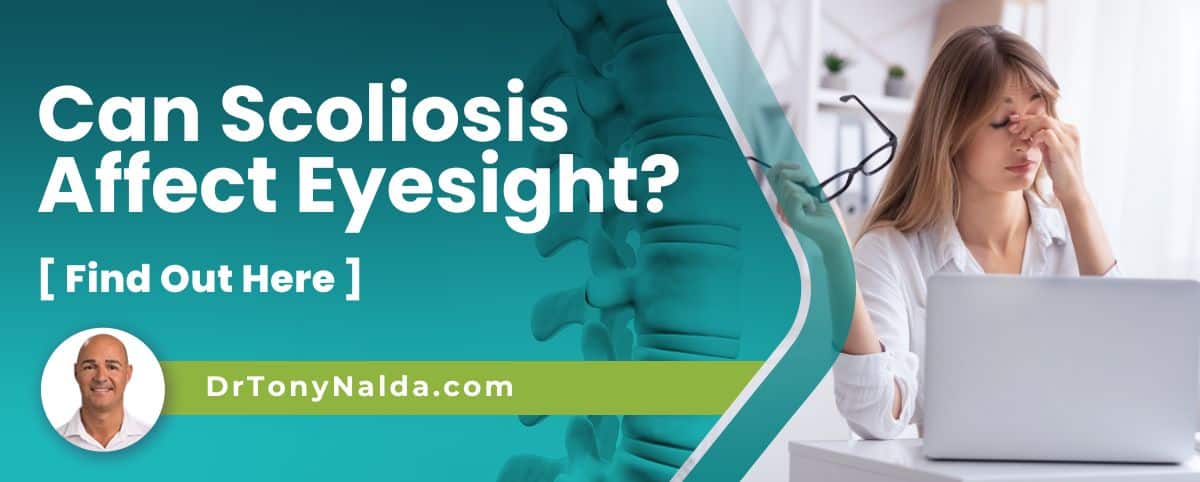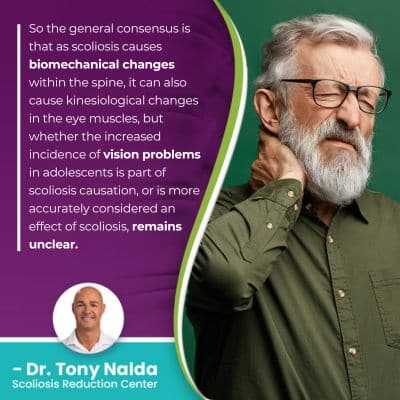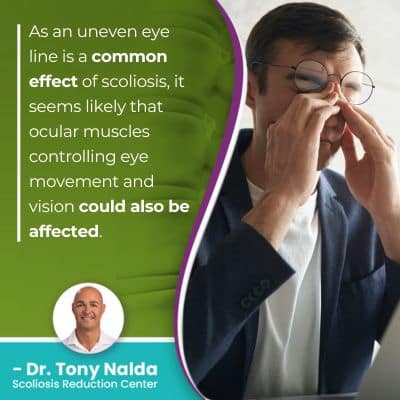Can Scoliosis Affect Eyesight? [ Find Out Here ]

Scoliosis is an asymmetrical condition, and many of its main effects are related to how the condition's uneven forces disrupt the body's overall symmetry. There are a number of ways scoliosis can affect the body, and not just in and around the spine. Continue reading to explore the link between scoliosis and vision problems.
Scoliosis is a spinal condition, but spinal conditions don't just affect the spine and its surrounding muscles and nerves; they can cause a number of unexpected effects, and eyesight can be one of them. While adolescent scoliosis is linked with vision problems, the nature of that link remains unclear.
Before getting to the link between scoliosis and vision problems, let's first discuss scoliosis generally, including how it's diagnosed and its main effects.
Table of Contents
What is Scoliosis?
Scoliosis is a highly-prevalent structural spinal condition that involves the development of an unnatural side to side spinal curvature that rotates, making it a 3-dimensional condition.
Current estimates have just under seven million people living with scoliosis in the United States alone, and scoliosis is the leading spinal deformity among school-aged children.
Scoliosis is diagnosed through a combined physical examination and X-ray results to see what's truly happening in and around the spine, to confirm there is a rotational component, and the patient's Cobb angle measurement.
A minimum Cobb angle measurement of at least 10 degrees is needed to reach a diagnosis of scoliosis, and Cobb angle is determined during X-ray by drawing lines from the tops and bottoms of the curve's most-tilted vertebrae, and the resulting angle is expressed in degrees.
The higher the Cobb angle, the more unnaturally-tilted the vertebrae are at the curve's apex, and the more severe the condition:
- Mild scoliosis: Cobb angle measurement of between 10 and 25 degrees
- Moderate scoliosis: Cobb angle measurement of between 25 and 40 degrees
- Severe scoliosis: Cobb angle measurement of 40+ degrees
- Very-severe scoliosis: Cobb angle measurement of 80+ degrees
The more severe a condition, the more noticeable its effects are likely to be, and the more likely it is to cause indirect effects like vision problems.
There are never treatment guarantees, but if treatment is started early in a condition's progressive line, there are fewer limits to what can be achieved, and that means preventing increasing condition severity and effects, such as visual changes.
In addition, scoliosis is a progressive condition, so where a scoliosis is the time of diagnosis, including its effects, isn't indicative of where it will stay; only proactive treatment can work towards counteracting the condition's progressive nature.
Scoliosis Effects
 The main effect of scoliosis in children is postural deviation, and this is caused by the condition's uneven forces disrupting the body's overall symmetry; oftentimes, the condition's earliest signs are uneven shoulders and hips.
The main effect of scoliosis in children is postural deviation, and this is caused by the condition's uneven forces disrupting the body's overall symmetry; oftentimes, the condition's earliest signs are uneven shoulders and hips.
- Additional postural changes can include:
- An uneven eye line
- Head appearing uncentered over the torso
- Uneven shoulder blades
- The development of a rib cage arch
- Arms and legs that appear to be different lengths
Additional changes can include disruptions to balance, coordination, proprioception, and gait.
While adults also experience postural changes, like a prominent lean to one side, the main symptom of scoliosis is pain, and that's because the condition doesn't become compressive until skeletal maturity has been reached.
In young patients who are still growing, the constant lengthening motion counteracts the compressive force of the unnatural spinal curve; it's compression (uneven pressure) of the spine and its surrounding muscles and nerves that causes the majority of condition-related pain.
Scoliosis pain can involve back pain, pain that radiates into the extremities due to nerve compression, and muscle pain.
There are also different types of scoliosis that can cause different effects such as idiopathic scoliosis, neuromuscular scoliosis, congenital scoliosis, and degenerative scoliosis; idiopathic scoliosis is considered typical, while the other types associated with known causes are considered atypical.
Now, let's focus on the link between scoliosis and vision problems.
Scoliosis and Vision Problems
Typical cases of idiopathic scoliosis, of which the most prevalent form is adolescent idiopathic scoliosis, diagnosed between the ages of 10 and 18, is linked with vision problems such as astigmatism, blindness, and myopia, but is that link direct, or indirect?
 Scoliosis that's left untreated, and/or severe cases, are the most likely to lead to vision problems because the condition's not being addressed and/or is a particularly severe form.
Scoliosis that's left untreated, and/or severe cases, are the most likely to lead to vision problems because the condition's not being addressed and/or is a particularly severe form.
In addition to changes to movement and coordination, proprioception is also commonly affected, and this refers to one's ability to orient their body position in the absence of visual cues; vision provides input into proprioception through body position and awareness.
Another effect of scoliosis is muscular imbalance; the muscles on each side of the spine can become unbalanced as the unnatural spinal curve pulls them in different directions, and as scoliosis causes postural changes and symmetrical changes throughout the body, including the face, what about the eye muscles?
As an uneven eye line is a common effect of scoliosis, it seems likely that ocular muscles controlling eye movement and vision could also be affected.
Studies have explored how scoliosis affects the visual field in adolescent idiopathic scoliosis; posture and balance is guided by integrative stimuli that includes visual, sensory, and the inner ear's vestibular system.
Research has identified a link between inadequate visual systems and the development of scoliosis, but there are many theories regarding the development of idiopathic scoliosis and most remain just that: theories.
It's also difficult to determine whether the link is because vision problems contribute to the development of idiopathic scoliosis, or that the development of idiopathic scoliosis causes poor vision.
Cerebrospinal Fluid, Vision, and Scoliosis
Another potential relationship between relatively poor vision and scoliosis is in how scoliosis can affect the flow and level of cerebrospinal fluid (CSF) in and around the brain.
Cerebrospinal fluid helps protect the brain and spinal cord by providing cushioning, eliminating waste, and making important nutrients available.
When the spine has an unnatural curvature, the flow of CSF fluid within is disrupted, and if a build up behind the eyes occurs, this is known as intracranial hypertension and is associated with headaches and vision problems.
So the general consensus is that as scoliosis causes biomechanical changes within the spine, it can also cause kinesiological changes in the eye muscles, but whether the increased incidence of vision problems in adolescents is part of scoliosis causation, or is more accurately considered an effect of scoliosis, remains unclear.
Idiopathic scoliosis isn't associated with a single-known cause, and is instead considered multifactorial: caused by a number of different factors that can vary from person to person, and scoliosis affecting the underlying mechanism informing CSF fluid levels, visual stimuli, and muscle strength and symmetry has been suggested as the link between the high number of adolescents with visual problems.
Conclusion
Although scoliosis is a structural spinal condition that involves the development of an unnatural spinal curve, it can affect the entire body, both with direct and indirect effects.
The main effects of scoliosis are caused by how the condition disrupts the body's overall symmetry, and that can mean postural changes, structural changes, and changes to how systems function within the body, including the ocular system.
When it comes to typical cases of idiopathic scoliosis in children, the effects are mainly postural, and when it comes to typical cases of idiopathic scoliosis in adults, the main effect is pain and postural changes.
Not all patients with scoliosis will have clinical vision problems, but for those who do, the best treatment is proactive treatment that addresses the underlying cause of the vision problems: the condition itself.
To address symptoms of scoliosis, the structural nature of the condition has to be addressed first and foremost, and here at the Scoliosis Reduction Center, patients benefit from a proactive conservative treatment approach that combines scoliosis-specific chiropractic care, physical therapy and exercises, corrective bracing, and rehabilitation.
Being proactive with treatment is important because progressive scoliosis doesn't just affect the spine, and condition effects will increase over time, and the more severe a condition is, the more likely it is that its effects are going to be widespread and include vision problems.
While the nature of the link is unclear, what we do know is that adolescent idiopathic scoliosis patients have more vision problems than adolescents without the spinal condition, but we don't fully understand whether vision problems are a factor that contributes to the development of AIS, or whether scoliosis causes eye diseases and issues.
Dr. Tony Nalda
DOCTOR OF CHIROPRACTIC
After receiving an undergraduate degree in psychology and his Doctorate of Chiropractic from Life University, Dr. Nalda settled in Celebration, Florida and proceeded to build one of Central Florida’s most successful chiropractic clinics.
His experience with patients suffering from scoliosis, and the confusion and frustration they faced, led him to seek a specialty in scoliosis care. In 2006 he completed his Intensive Care Certification from CLEAR Institute, a leading scoliosis educational and certification center.
About Dr. Tony Nalda
 Ready to explore scoliosis treatment? Contact Us Now
Ready to explore scoliosis treatment? Contact Us Now





